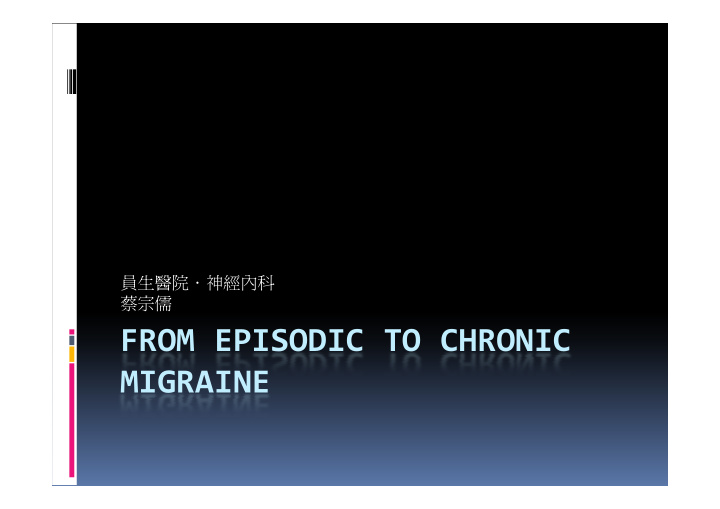



員生醫院.神經內科 蔡宗儒 FROM EPISODIC TO CHRONIC MIGRAINE
INTRODUCTION
Migraine � Migraine is a common neurologic disorder that has a wide variety of subtypes, many comorbidities, and a variable prognosis.
Prevalence � 美國 � 女性: 18% � 男性: 6.5% � 台灣十五歲以上的成人 � 台灣十五歲以上的成人 � 女性 : 14.4% 女性: 女性 女性 : : � 男性: 4.5% � 慢性每日頭痛: 3.2% ������������������������������ ������������������������������� ���� ���
Definition � Recurrent headache disorder manifesting in attacks lasting 4 – 72 hours. � Typical characteristics of the headache are unilateral location, pulsating quality, unilateral location, pulsating quality, moderate or severe intensity, aggravation by routine physical activity and association with nausea and/or photophobia and phonophobia.
Diagnostic Criteria – 1.1 Migraine without Aura � A. At least 5 attacks fulfilling criteria B-D � B. Headache attacks lasting 4-72 hours (untreated or unsuccessfully treated) � C. Headache has at least two of the following characteristics: � 1. Unilateral location 1. Unilateral location � 2. Pulsating quality � 3. Moderate or severe pain intensity � 4. Aggravation by or causing avoidance of routine physical activity (eg, walking or climbing stairs) � D. During headache at least one of the following: � 1. Nausea and/or vomiting � 2. Photophobia and phonophobia � E. Not attributed to another disorder ������������������������������������ ��!�����"����!��� ������������������������������������ ��!�����"����!���� ���!�#!����� ��!�#!����� ��$�����%��&�'���(�����)�$$��(�����&����� ��$�����%��&�'���(�����)�$$��(�����&�����
Diagnostic Criteria – 1.5.1 Chronic Migraine (CM) � Description: � Migraine headache ≧ 15 days/month, > 3 months � Absence of medication overuse � Diagnostic criteria: � Diagnostic criteria: � A. Headache fulfilling criteria C and D for 1.1 Migraine without aura on ≥15 days/month for >3 months � B. Not attributed to another disorder ������������������������������������ ��!�����"����!��� ������������������������������������ ��!�����"����!���� ���!�#!����� ��!�#!����� ��$�����%��&�'���(�����)�$$��(�����&����� ��$�����%��&�'���(�����)�$$��(�����&�����
�������%*����+����,)�$$���-�)� �������%*����+����,)�$$���-�)� – )� )�
CLINICAL COURSE IN MIGRAINE IN MIGRAINE
Clinical Course in Migraine � The conceptual framework for understanding migraine has evolved over the past decade. � More recent evidence supports the concept that migraine is a chronic disorder with that migraine is a chronic disorder with episodic attacks. � Between headaches, patients with migraine have an enduring predisposition to attacks including abnormalities in brain excitability and impaired health-related quality of life. �������%*������������ �������%*������������ – �.. �..
Pathway in the Natural History of Migraine � � � � ����������������������� �������%*������������ �������%*������������ – �.. �..
Four Distinct States of Migraine No migraine No migraine High High- -frequency episodic migraine frequency episodic migraine ������������������������������������������������������������������������������������������������������������������������ ������������������������������������������������������������������������������������������������������������������������ Low Low- -frequency episodic migraine frequency episodic migraine Chronic migraine (CM) Chronic migraine (CM) �������%*����+����,)�$$���-�)� – )� �������%*����+����,)�$$���-�)� )�
TRANSFORMATION OF MIGRAINE
Transformation of Migraine � Daily or near-daily headaches with migrainous features and/or attacks have been described in the literature with multiple names and different classifications (eg, names and different classifications (eg, transformed migraine, chronic migraine).
Chronic daily headache (CDH) = Chronic migraine = Transformed migraine ? Transformed migraine ?
Chronic Daily Headache � CDH: high frequency of headaches (15 days/month) �������%*����+����,)�$$���-�)� �������%*����+����,)�$$���-�)� – )� )�
� Cluster headache � Paroxysmal hemicrania Short-duration � Short-lasting unilateral neuralgiform headache attacks � Idiopathic stabbing headache Primary 4 h/d � Hypnic headache � CM Long-duration Long-duration - - � Hemicrania continua Hemicrania continua � Chronic tension-type headache Underlying cause � New daily persistent headache + � Medication overuse � Head trauma Secondary � Cervical spine disorders � Vascular disorders �������%*����+����,)�$$���-�)� �������%*����+����,)�$$���-�)� – )� )�
Chronic Daily Headache � Long-duration CDH is a prevalent problem, with 3% to 5% of the worldwide population experiencing daily or near-daily headaches. � Most patients with long-duration primary � Most patients with long-duration primary CDH have CM. �������%*����+����,)�$$���-�)� �������%*����+����,)�$$���-�)� – )� )�
Transformation of Migraine � Clinical transformation: increases in attack frequency over time leading to CM, occurs in about 3% of episodic migraine sufferers. � Physiologic transformation: physiologic changes � Physiologic transformation: physiologic changes in the CNS manifested through alterations in in the CNS manifested through alterations in nociceptive thresholds (allodynia) and in pain pathways. � Anatomic transformation: definitive brain lesions including stroke and deep white matter lesions emerge “ �������������������(�%����� �������������������(�%����� ” &��������%*������������ &��������%*������������ – �.. �..
Transformation of Migraine � Although the data for anatomic changes are for patients with episodic migraine with aura only, we consider it a form of migraine as transformation because the prevalence of transformation because the prevalence of brain lesions seems to increases with attack frequency. “ �������������������(�%����� �������������������(�%����� ” &��������%*������������ &��������%*������������ – �.. �..
Conceptual Framework for Transitions in Migraine � Although it is not well established if migraine may not progress abruptly, clinical evidence suggests that most frequently attacks increase in frequency over a period of time. � All transition rates can be modeled as a function of demographic, environmental, and genetic risk factors. “ �������������������(�%����� �������������������(�%����� ” &��������%*������������ &��������%*������������ – �.. �..
Recommend
More recommend